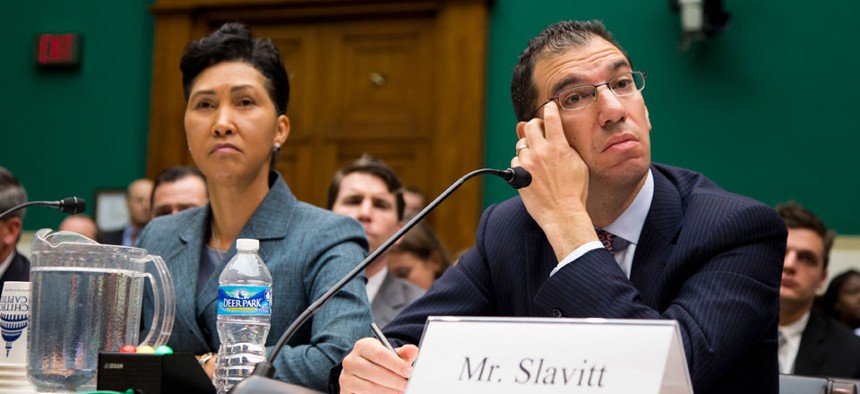
Cheryl Campbell, senior vice president of CGI listens at left as Andy Slavitt, representing QSSI's parent company, testified on Oct. 24 Evan Vucci/AP
Analysis: 3 Ways to Avoid Another HealthCare.gov Mess
Simplify contracting rules, focus on quality and upgrade the workforce.
There are three sides to every story: yours, mine, and the truth. The old adage is spot on for the recent congressional oversight hearings on the troubled launch of HealthCare.gov.
Contractors have pointed the finger at the Centers for Medicare and Medicaid Services, citing insufficient guidance, inadequate resources, a lack of authority to lead the project and changes requested a month before the site went live. In testimony to the House Committee on Energy and Commerce, Cheryl Campbell of CGI Federal Inc. deflected blame. “CMS serves the important role of systems integrator or ‘quarterback’ on this project and is the ultimate responsible party for the end-to-end performance of the overall federal exchange,” she said.
But CMS officials pointed the finger at the more than 50 contractors on the project, saying vendors relied on outdated software and failed to coordinate and adequately plan for the anticipated wave of users. Days after contractors came before Congress, CMS Administrator Marilyn Tavenner pushed back in her Oct. 29 testimony to the House Committee on Ways and Means. “CMS has a track record of successfully overseeing the many contractors our programs depend on to function,” she said. “Unfortunately, a subset of those contracts for HealthCare.gov have not met expectations.”
Committee members on both sides of the aisle joined in the blame game, with majority Republicans relishing the opportunity to excoriate Health and Human Services Secretary Kathleen Sebelius and the Obama administration, and minority Democrats criticizing private sector contractors for pursuing revenue growth at the expense of developing a workable website.
The truth?
From bidding to selection to delivery, the federal contracting system is broken. HealthCare.gov is not the first major information technology purchase to be over budget, late and dysfunctional. It’s only the most recent. The system is plagued by a litany of problems. The rules are cumbersome, inflexible and vary across agencies. The process favors large and sometimes politically connected incumbents, splinters projects across congressional districts and focuses on compliance rather than quality products that support agency missions. The federal contracting workforce is understaffed, overburdened and undertrained.
The federal government spends $500 billion annually on contracts, almost half its discretionary spending when entitlements are excluded. Agencies buy everything from paper clips to aircraft carriers. The average federal employee is more likely to oversee and manage a third party provider than to deliver a service directly to a recipient. If Congress and the Obama administration were to decide tomorrow that they want the government to design, build and maintain IT systems like HealthCare.gov, it would take years to hire the array of required technical specialists. To fight wars with the most sophisticated, technologically advanced weapon systems, track the spread of virulent diseases with globally integrated health data and secure the homeland against cyber threats, the government has to go to the market.
There are several pathways out of this mess:
- Simplify and standardize the rules across agencies. If a contractor wants to sell the same product to different agencies, the company often has to comply with a different set of complicated regulations for each agency. The result: Many contractors who could provide value to the government elect not to. The Office of Federal Procurement Policy and individual agencies should streamline regulations and reduce variation across government.
- Focus the system on delivering quality rather than compliance. The broad goal of federal procurement policy is to deliver “best value” -- a combination of cost and quality -- but the process focuses federal managers on adhering to the array of byzantine rules. The last thing a procurement professional wants is an exposé above the fold in a major newspaper or to be called before a congressional committee because he failed to follow the rules. Congressional and administrative overseers should focus more on whether a system delivers products that help agencies fulfill their missions, than on whether every rule was followed.
- Upgrade the workforce. Contracting has long been the backwater of government. Most people wind up in the job by chance rather than by choice. They often have limited career mobility and lack training for the complexity of the products they are buying. The federal government needs to take a page from the private sector, which has integrated supply chain management and strategic sourcing into the core of its managerial activities. Chief purchasing officers in the private sector serve in central roles akin to chief financial officers.
HealthCare.gov is a textbook case of how not to buy something. The lesson? Congress and the administration should stop warring about whether to keep the government running and focus on how to make the government run well. They should fix federal procurement policy and practice in an era of growing dependence on contractors for critical functions.
Trevor Brown is interim director of Ohio State University’s John Glenn School of Public Affairs, and David Van Slyke is the Louis A. Bantle Chair in Business and Government Policy at Syracuse University’s Maxwell School of Citizenship and Public Service.They are the authors of Complex Contracting: Government Purchasing in the Wake of the U.S. Coast Guard's Deepwater Program (Cambridge University Press, 2013).






